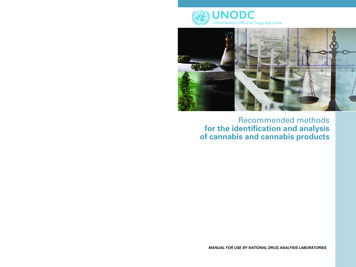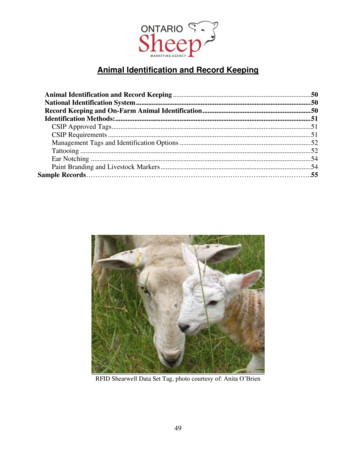
Transcription
Vienna International Centre, PO Box 500, 1400 Vienna, AustriaTel.: ( 43-1) 26060-0, Fax: ( 43-1) 26060-5866, www.unodc.orgRecommended methodsfor the identification and analysisof cannabis and cannabis productsUnited Nations publicationPrinted in AustriaUSD 15ISBN 978-92-1-148242-3Sales No. E.09.XI.15ST/NAR/40*0983942*V.09-83942—September 2009—340Manual for use by national drug analysis laboratories
Photo credits:UNODC Photo Library; UNODC/Ioulia Kondratovitch; Alessandro Scotti.
Laboratory and Scientific SectionUnited Nations Office on Drugs and CrimeViennaRecommended Methods forthe Identification and Analysis ofCannabis and Cannabis Products(Revised and updated)MANUAL FOR USE BYNATIONAL DRUG ANALYSIS LABORATORIESUNITED NATIONSNew York, 2009
NoteOperating and experimental conditions are reproduced from the original referencematerials, including unpublished methods, validated and used in selected nationallaboratories as per the list of references. A number of alternative conditions andsubstitution of named commercial products may provide comparable results in manycases, but any modification has to be validated before it is integrated into laboratoryroutines.Mention of names of firms and commercial products does not imply the endorsementof the United Nations.ST/NAR/40UNITED NATIONS PUBLICATIONSales No. E.09.XI.15ISBN 978-92-1-148242-3This publication has not been formally edited.Original language: English
AcknowledgementsThe Laboratory and Scientific Section (headed by Justice Tettey) of the United NationsOffice on Drugs and Crime (UNODC) wishes to express its thanks to the followingexperts for their contribution to the contents of the present manual:Dr. Michael Bovens and Mr. Markus Schläpfer, Scientific Forensic Service,Zurich City Police, SwitzerlandMs. Sue Fiddian, Manager, Botany Branch, Forensic Services Department,Victoria Police, Australia; and Illicit Drugs Specialist Advisory Group forSenior Managers of Australian and New Zealand Forensic Laboratories(SMANZFL)Mr. Andrew Holmes, Senior Scientific Advisor, Drug Analysis Service, HealthCanada, Toronto, CanadaDr. Henk Huizer, Drugs Department, Netherlands Forensic Institute, The Hague,The Netherlands (retired)Mr. A. Kader Jackaria, Forensic Chemist and Toxicologist, MauritiusDr. Lee Tong Kooi, Division Director, Illicit Drugs and Toxicology Division,Applied Sciences Group, Health Sciences Authority, SingaporeMr. Adriano Otávio Maldaner and Ms. Daniele Zago Souza, Federal CriminalPolice, BrazilDr. H. Stambouli, Forensic Science Laboratory, Gendarmerie Royale, Rabat,MoroccoDr. Kalman Szendrei, Professor emeritus, Albert Szent-Györgyi University,Szeged, HungaryUNODC’s Laboratory and Scientific Section also wishes to express its thanksto Dr. Michael Bovens and Markus Schläpfer for reviewing and updating theoriginal manual “Recommended methods for testing cannabis”, for preparingthe initial draft of the present revised and updated manual, and for finalizingthe manuscript, using additional contributions from the above experts.*Barbara Remberg coordinated this publication for UNODC and wishes toacknowledge the contribution of other UNODC staff.*Dr. Bovens wishes to acknowledge Ms. Lisa Frischknecht for editorial assistance of the initial draft.iii
ContentsPage1.INTRODUCTION. . . . . . . . . . . . . . . . . . . . . . . . . . . . . . . . . . . . . . . . . . . . . .1.1 Background. . . . . . . . . . . . . . . . . . . . . . . . . . . . . . . . . . . . . . . . . . . . . .1.2 Purpose and use of the manual. . . . . . . . . . . . . . . . . . . . . . . . . . . . . .1122. ILLICIT PRODUCTION OF CANNABIS PRODUCTS . . . . . . . . . . . . . . .2.1 Cannabis market. . . . . . . . . . . . . . . . . . . . . . . . . . . . . . . . . . . . . . . . . .553. DESCRIPTION OF THE CANNABIS PLANT AND ILLICITCANNABIS PRODUCTS. . . . . . . . . . . . . . . . . . . . . . . . . . . . . . . . . . . . . . . .3.1 Name . . . . . . . . . . . . . . . . . . . . . . . . . . . . . . . . . . . . . . . . . . . . . . . . .3.2 Synonyms. . . . . . . . . . . . . . . . . . . . . . . . . . . . . . . . . . . . . . . . . . . . . . . .3.3 Taxonomy . . . . . . . . . . . . . . . . . . . . . . . . . . . . . . . . . . . . . . . . . . . . . . .3.4 Physical appearance . . . . . . . . . . . . . . . . . . . . . . . . . . . . . . . . . . . . . . .3.5 Similarities. . . . . . . . . . . . . . . . . . . . . . . . . . . . . . . . . . . . . . . . . . . . . . .3.6 Breeding. . . . . . . . . . . . . . . . . . . . . . . . . . . . . . . . . . . . . . . . . . . . . . . . .3.6.1Sinsemilla (Spanish for: “no seed”) . . . . . . . . . . . . . . . . . . .3.6.2Cloning . . . . . . . . . . . . . . . . . . . . . . . . . . . . . . . . . . . . . . . . . .3.6.3Artificially induced hermaphrodites. . . . . . . . . . . . . . . . . . . .3.6.4Outdoor production. . . . . . . . . . . . . . . . . . . . . . . . . . . . . . . . .3.6.5Indoor production. . . . . . . . . . . . . . . . . . . . . . . . . . . . . . . . . .3.7 Industrial cannabis. . . . . . . . . . . . . . . . . . . . . . . . . . . . . . . . . . . . . . . . .3.8 Flowering. . . . . . . . . . . . . . . . . . . . . . . . . . . . . . . . . . . . . . . . . . . . . . . .3.9 Harvesting. . . . . . . . . . . . . . . . . . . . . . . . . . . . . . . . . . . . . . . . . . . . . . .3.10 Yield . . . . . . . . . . . . . . . . . . . . . . . . . . . . . . . . . . . . . . . . . . . . . . . . .3.11 9-THC distribution in cannabis plants and products. . . . . . . . . . . . .3.12 Biosynthesis. . . . . . . . . . . . . . . . . . . . . . . . . . . . . . . . . . . . . . . . . . . . . .3.13 Cannabis products. . . . . . . . . . . . . . . . . . . . . . . . . . . . . . . . . . . . . . . . .3.13.1 Herbal cannabis. . . . . . . . . . . . . . . . . . . . . . . . . . . . . . . . . . . .3.13.2 Cannabis resin (hashish). . . . . . . . . . . . . . . . . . . . . . . . . . . . .3.13.2.1 Cannabis resin from Mediterranean countries. . .3.13.2.2 Cannabis resin from South and South-West Asia.3.13.2.3 Cannabis resin from “pollinators”/“ice-o-lators”. .3.13.3 Liquid cannabis (hashish oil). . . . . . . . . . . . . . . . . . . . . . . . .3.13.4 Cannabis seeds and cannabis seed oil. . . . . . . . . . . . . . . . . .3.13.5 Cannabis essential oil. . . . . . . . . . . . . . . . . . . . . . . . . . . . . . .3.14 Estimation of the age of cannabis samples. . . . . . . . . . . . . . . . . . . . .3.15 Drug-type versus fibre-type cannabis. . . . . . . . . . . . . . . . . . . . . . . . . 920v
Page4. CHEMICAL CONSTITUENTS OF FORENSIC SIGNIFICANCE. . . . . . . 215. QUALITATIVE AND QUANTITATIVE ANALYSIS OFCANNABIS PRODUCTS. . . . . . . . . . . . . . . . . . . . . . . . . . . . . . . . . . . . . . . .5.1 Sampling . . . . . . . . . . . . . . . . . . . . . . . . . . . . . . . . . . . . . . . . . . . . . . . .5.1.1Sampling of plants (indoor and outdoor plantations). . . . . .5.1.2Sampling of seized cannabis products. . . . . . . . . . . . . . . . . .5.1.2.1 Herbal cannabis. . . . . . . . . . . . . . . . . . . . . . . . . . . .5.1.2.2 Cannabis resin. . . . . . . . . . . . . . . . . . . . . . . . . . . . .5.1.2.3 Liquid cannabis (oil). . . . . . . . . . . . . . . . . . . . . . . .5.2 Minimum criteria for positive identification of cannabis. . . . . . . . . .5.3 Physical examination. . . . . . . . . . . . . . . . . . . . . . . . . . . . . . . . . . . . . . .5.3.1Macroscopic characteristics. . . . . . . . . . . . . . . . . . . . . . . . . .5.3.2Microscopic characteristics. . . . . . . . . . . . . . . . . . . . . . . . . . .5.4 Chemical examination. . . . . . . . . . . . . . . . . . . . . . . . . . . . . . . . . . . . . .5.4.1General aspects. . . . . . . . . . . . . . . . . . . . . . . . . . . . . . . . . . . .5.4.2Sample preparation for chemical examination. . . . . . . . . . .5.4.2.1 Preparation of herbal cannabis. . . . . . . . . . . . . . . .5.4.2.2 Preparation of cannabis resin. . . . . . . . . . . . . . . . .5.4.2.3 Preparation of cannabis oil. . . . . . . . . . . . . . . . . . .5.4.3Presumptive tests . . . . . . . . . . . . . . . . . . . . . . . . . . . . . . . . . .5.4.3.1 Colour tests . . . . . . . . . . . . . . . . . . . . . . . . . . . . . . .5.4.3.2 Immunoassays . . . . . . . . . . . . . . . . . . . . . . . . . . . . .5.4.4Ion mobility spectrometry (IMS). . . . . . . . . . . . . . . . . . . . . .5.4.5Thin-layer chromatography (TLC). . . . . . . . . . . . . . . . . . . . .5.4.6 Gas chromatography-flame ionization detection (GC-FID),without and with derivatization. . . . . . . . . . . . . . . . . . . . . . .5.4.6.1 Capillary column technique . . . . . . . . . . . . . . . . . .5.4.7Gas chromatography-mass spectrometry (GC-MS) . . . . . . .5.4.8High-performance liquid chromatography (HPLC) . . . . . . .393941416. ADDITIONAL ANALYTICAL TECHNIQUES AND APPROACHESFOR THE ANALYSIS OF CANNABIS PRODUCTS. . . . . . . . . . . . . . . . .6.1 GC-FID profiling of seizures of cannabis products. . . . . . . . . . . . . .6.2 Solid phase-micro extraction (SPME). . . . . . . . . . . . . . . . . . . . . . . . .6.3 Stable isotope ratio-mass spectrometry (IRMS). . . . . . . . . . . . . . . . .6.4 DNA profiling. . . . . . . . . . . . . . . . . . . . . . . . . . . . . . . . . . . . . . . . . . . 636367. REFERENCES. . . . . . . . . . . . . . . . . . . . . . . . . . . . . . . . . . . . . . . . . . . . . . . . . 47vi
1.Introduction1.1 BackgroundCannabis products are the most widely trafficked drugs worldwide, accounting for65 per cent of all global seizure cases (1.65 million cases) in 2006. 5,200 metric tonsof herb and 1,000 metric tons of resin were seized in 2006. Practically all countries inthe world are affected by cannabis trafficking. Similarly, cannabis also remains the mostwidely used drug worldwide, with an estimated 166 million people having used cannabisin 2006, equivalent to some 4 per cent of the global population aged 15-64.At the same time, especially since the end of the last century, production methodshave become increasingly sophisticated, resulting in the availability in illicit marketsof a wide range of cannabis products with widely varying levels of the main psychoactive ingredient, delta-9-tetrahydrocannabinol (THC). Most recently, there has alsobeen a renewed debate about increasing THC content (frequently referred to as“potency”) in illicit cannabis products.All of this requires analytical data which are comparable between laboratories andover time. However, most countries do not require by law the detailed analysis ofthe THC content of the different products, and where such analyses are carried out,they use a variety of approaches and experimental designs, reducing the comparabilityof results. For example, the conversion of natural constituents, such as tetrahydrocannabinolic acid (THCA), by both smoking and under certain analytical conditionsinto THC, and how this should be reflected in the analytical report, are issues whichare not yet standardized worldwide. On the technological side, the analysis ofcannabis products is further complicated by the relatively restricted availability ofpure or well defined reference material of THC and other cannabinoids.*The present manual is an updated and significantly revised version of the manualon “Recommended methods for testing cannabis” (ST/NAR/8), which was publishedin 1987. It has been prepared taking into account both developments in analyticaltechnology and advances in the science of cannabis, and with a view to providingthe analytical basis for an objective discussion about changes in THC content overtime, and differences between regions and products.*In this connection, it is important to be aware that THC was fully characterized only in the mid1960s, and was only available as pure reference standard from the late 1960s. Results obtained beforethat time therefore should not be compared with today’s results, and must be considered approximate.1
2Recommended methods for the identification and analysis of cannabis and cannabis products1.2 Purpose and use of the manualThe present manual is one in a series of similar publications dealing with the identification and analysis of various types of drugs under international control. Thesemanuals are the outcome of a programme pursued by UNODC since the early 1980s,aimed at the harmonization and establishment of recommended methods of analysisfor national drug analysis laboratories.In line with the overall objective of the series, the present manual suggests approachesthat may assist drug analysts in the selection of methods appropriate to the sampleunder examination and provide data suitable for the purpose at hand, leaving roomalso for adaptation to the level of sophistication of different laboratories and thevarious legal needs. The majority of methods included in the present manual arevalidated methods, which have been used for a number of years in reputable laboratories and as part of inter-laboratory studies, collaborative exercises and proficiencytests. The reader should be aware, however, that there are a number of other methods,including those published in the forensic science literature, which may also produceacceptable results. Any new method that is about to be used in the reader’slaboratory must be validated and/or verified prior to routine use.In addition, there are a number of more sophisticated approaches, but they may notbe necessary for routine operational applications. Therefore, the methods describedhere should be understood as guidance, that is, minor modifications to suit localcircumstances should not normally change the validity of the results. The choice ofthe methodology and approach to analysis as well as the decision whether or notadditional methods are required remain with the analyst and may also be dependenton the availability of appropriate instrumentation and the level of legally acceptableproof in the jurisdiction within which the analyst works.Attention is also drawn to the vital importance of the availability to drug analystsof reference materials and books on drugs of abuse and analytical techniques. Moreover, the analyst must of necessity keep abreast of current trends in drug analysis,consistently following current analytical and forensic science literature.UNODC’s Laboratory and Scientific Section would welcome observations on thecontents and usefulness of the present manual. Comments and suggestions may beaddressed to:Laboratory and Scientific SectionUnited Nations Office on Drugs and CrimeVienna International CentreP.O. Box 5001400 ViennaAustriaFax: ( 43-1) 26060-5967E-mail: Lab@unodc.org
Recommended methods for the identification and analysis of cannabis and cannabis products3All manuals, as well as guidelines and other scientific-technical publications maybe requested by contacting the address above.
2. Illicit production of cannabisproducts2.1 Cannabis marketCannabis products are by far the most abused drugs on the illicit drug market.Cannabis can be grown in virtually any country, and is increasingly cultivatedindoors in technically advanced countries.Production of herbal cannabis (marihuana) is widely dispersed, existing in almostevery country in the world. Cannabis resin (hashish) is produced in about 65 countries, with main sources being North Africa and countries in South-West Asia,particularly Afghanistan and Pakistan.Africa is home to the world’s leading producer of (outdoor) cannabis resin—Morocco, the site of the largest known cannabis cultivation area. Most of thecannabis resin seized in Europe continues to be trafficked from Morocco. The resinfrom that country shares characteristics with resin from other, southern and easternMediterranean countries (see section 3.13.2.1).Afghanistan is the world’s second largest producer of resin from cannabis, grownalongside opium poppy fields. Resin from that country shares characteristics withresin from other parts of the Indian subcontinent (see section 3.13.2.2). Lebanonwas once one of the world’s leading resin suppliers and might still be if it were notfor continued eradication efforts.With regard to herbal cannabis, the American continent accounted for some55 per cent of global production in 2006, followed by Africa (about 22 per cent).Most herbal cannabis is produced for domestic markets and for export to neighbouring countries, i.e. international trafficking in herbal cannabis is rather limited.Since the 1970s, cannabis growers in North America and Europe have been workingto create more potent cannabis, and the market for high-potency, indoor-producedsinsemilla (see section 3.6.1) is growing in many key consumption countries. Sinsemilla potency has increased dramatically in the last decade in the United States,Canada, and The Netherlands—the three countries at the vanguard of cannabis breeding and production technology—and there are indications that its market share isgrowing in many other countries.5
6Recommended methods for the identification and analysis of cannabis and cannabis productsHowever, there is no evidence that the effective potency* of cannabis on the European market has increased significantly. This is because in most European countriesimported cannabis (herbal and resin) continues to dominate the market and thepotency of these imported products has remained stable over many years at around6-8 per cent. The increase in cannabis potency observed in some countries sincethe end of the 1990s is the result of the increased availability of home-producedherbal cannabis, which is cultivated using high THC breeds and intensive hydroponictechniques. Indoor cultivation of herbal cannabis now occurs in most, if not all,European countries. However, despite this trend towards home-grown (indoor) cultivation in Europe, import of cannabis products from outdoor cultivation, mainlycannabis resin, is still observed, especially in Central Europe [1, 2].Limited time-series data on cannabis potency suggest that the mean 9-THC concentration in home-produced herbal cannabis seizures increased from around 1.5 per centin the 1980s to around 4 per cent in the late 1990s and around 10 per cent in the lastfive years [3, 4]. Recent reports from some European countries suggest mean THCconcentrations (potency) of up to 15-20 per cent in certain herbal materials, but thereis significant variation between samples even within a given year [5, 6, 7, 8].Although the high-potency indoor herbal cannabis has a higher THC content thanthe cannabis resin from Morocco, the latter is still being sold in Europe andconsidered by experienced cannabis users to produce a good high.A more detailed and up-to-date overview of the worldwide production, traffickingand use of cannabis can be found in the annual World Drug Reports published bythe United Nations Office on Drugs and Crime [9].*The term “effective potency” refers to the weighted mean potency of all cannabis products, takinginto account their relative availability.
3. Description of the cannabis plantand illicit cannabis products3.1 NameCannabis sativa L. (Linnaeus)3.2 SynonymsThere are many local and street names and synonyms used for cannabis and it isbeyond the scope of this manual to list them all. They include: hemp, marihuana,marijuana, pot, gandia, grass, chanvre and many more [10].3.3 TaxonomyThe genera Cannabis and Humulus (hops) belong to the same family (Cannabaceae,sometimes known as Cannabinaceae). Generally, cannabis is considered to be monospecific (Cannabis sativa L.) which is divided into several subspecies (C. sativasubsp. sativa, C. sativa subsp. indica, C. sativa subsp. ruderalis, C. sativa subsp.spontanea, C. sativa subsp. kafiristanca) [11]. However, the chemical and morphological distinctions by which cannabis has been split into these subspecies are oftennot readily discernible, appear to be environmentally modifiable, and vary in acontinuous fashion. For most purposes, it will suffice to apply the name Cannabissativa to all cannabis plants encountered [12].3.4 Physical appearanceCannabis is an annual, dioecious,* flowering herb. Staminate (male) plants areusually taller but less robust than pistillate (female) plants. Stems are erect and canvary from 0.2-6 m. However, most of the plants reach heights of 1-3 m. The extentof branching, like the plant height, depends on environmental and hereditary factorsas well as the method of cultivation (see also section 5.3.1).*The majority of plants is dioecious (i.e. male and female flowers are found on separate plants),although monoecious plants (i.e. bearing both male and female flowers) may also be encountered.7
8Recommended methods for the identification and analysis of cannabis and cannabis productsFigure 1.Morphological aspects of Cannabis sativa L. [13]A Inflorescence of male (staminate)plantB Fruiting female (pistillate) plant1 Staminate flower2 Stamen (anther and short filament)3 Stamen4 Pollen grains5 Pistillate flower with bract6 Pistillate flower without bract7 Pistillate flower showing ovary(longitudinal section)8 Seed (achene*) with bract9 Seed without bract10 Seed (side view)11 Seed (cross section)12 Seed (longitudinal section)13 Seed without pericarp (peeled)*The seed is actually a fruit, or technically, an achene. It contains a single seed with a hard shell.
Recommended methods for the identification and analysis of cannabis and cannabis products93.5 SimilaritiesSeveral plant species bear morphological characteristics that show more or lessresemblance to Cannabis sativa. Some of them are illustrated below. However, acloser look at their macroscopic and/or microscopic characteristics makes confusionvery unlikely [12]. In addition, there are also simple presumptive tests available todifferentiate Cannabis sativa from other plant materials (see section 5.4.3).Figure 2. Some plant species which bear morphological characteristics withsome resemblance to Cannabis sativa L.Acer palmatumHibiscus cannabinusUrtica cannabina(Picture: [14])Dizygotheca elegantissima(Picture: [15])
10Recommended methods for the identification and analysis of cannabis and cannabis productsFigure 2. Some plant species which bear morphological characteristics withsome resemblance to Cannabis sativa L. (continued)Potentilla recta(Picture: [16])Datisca cannabinaSeeds of the common hop (Humulus lupulus) and Japanese hop (Humulus japonicus)might be confused with the seeds of Cannabis sativa. However, the presence of acharacteristic reticulate (“tortoise shell”) pattern on the surface of cannabis seedsenables them to be identified readily.Figure 3. Seeds which bear morphological characteristics with someresemblance to the seeds of Cannabis sativa L.Cannabis sativaHumulus lupulusHumulus japonicus3.6 BreedingThe plant is best suited to well structured neutral to alkaline clay and loam soils,with good water-holding capacity, which are not subject to water logging.Among many trials of breeding, crossing sativa and indica strains led to the development of “skunk”, a hybrid said to be 75 per cent sativa and 25 per cent indica.
Recommended methods for the identification and analysis of cannabis and cannabis products11This strain is said to be one of the first which combines the high THC content ofC. sativa subsp. sativa with the rapid growth cycle and yield of C. sativa subsp.indica. In some countries, cannabis with a high THC content is generally referredto as “skunk” today.3.6.1 Sinsemilla (Spanish for: “no seed”)The term sinsemilla refers to a cultivation technique rather than a genetic strain.Cannabis with the highest level of THC is comprised exclusively of the femaleflower heads (“buds”) that remain unfertilized throughout maturity and which, consequently, contain no seeds. The production of sinsemilla requires identifying thefemale plants and ensuring that they are not exposed to pollen.3.6.2 CloningThe first and most obvious boost to sinsemilla production was the use of clones.Cloning simply means propagating from a successful “mother” plant. This cuttingis rooted and transplanted. It is a genetic duplicate of its mother and thus can beused to create even more cuttings. A square metre of mother plants can providenumerous clones a week.3.6.3 Artificially induced hermaphroditesAlthough genetics disposes a plant to become male or female, environmental factors,including the diurnal light cycle, can alter the sex (hermaphrodites). Natural hermaphrodites with both male and female parts are usually sterile, but artificially inducedhermaphrodites can have fully functional reproductive organs. “Feminized” seedssold by many commercial seed suppliers are gained from artificially hermaphroditicfemales that lack the male chromosome or by treating the seeds with hormones orsilver thiosulfate. Thus, production of only pistillate (female) plants can be achievedby seed as well [17,18].3.6.4 Outdoor productionThe main production of cannabis worldwide is still outdoors and these plants aregenerally but not necessarily grown from seeds.Outdoor sinsemilla production is realized by identifying and destroying male plantsbefore pollination or by the use of artificially induced hermaphroditic females (seesection 3.6.3).
12Recommended methods for the identification and analysis of cannabis and cannabis products3.6.5 Indoor productionGrowing cannabis from seed means that half of the crop might be unwanted maleplants. For cost-intensive greenhouse production this is usually avoided, whichcan be achieved easily by cloning. Cloning and indoor production go hand inhand. Indoor production is mainly encountered in technologically advanced countries, where big basements or closed factories are usually used. One or morerooms in houses or other dwellings are also frequently converted into grow roomsoften using hydroponic techniques, i.e. growing plants in nutrient solutions insteadof soil.In soil, the optimum pH for the plant is 6.5 to 7.2. In hydroponic growing, thenutrient solution is best at 5.2 to 5.8, making cannabis well-suited to hydroponics,and thus indoor production, because this pH range is hostile to most bacteria andfungi [19].An example and overview of trends in illicit cannabis cultivation in the United Kingdom,including relevant legal and forensic implications, can be found in [20].3.7 Industrial cannabisIndustrial cannabis (industrial hemp) comprises a number of varieties of Cannabissativa L. that are intended for agricultural and industrial purposes. They are grownfor their seeds and fibres. Industrial cannabis is characterized by low THC contentand high cannabidiol (CBD) content. In most European countries the current upperlegal limit for cultivation is 0.2 per cent THC (Canada: 0.3 per cent). The ratio ofCBD to THC is greater than one.In many countries, “lists of approved cultivars” exist. Varieties which are consistentlyfound to exceed the legally acceptable levels for THC may be removed from theselists.Harvesting for fibres occurs at the end of flowering of the female plants and beforeseed formation.3.8 FloweringFlowering usually starts when darkness exceeds eleven hours per day. The floweringcycle can last anywhere between four and twelve weeks, depending on the strainand environmental conditions. Flowering times given by seed companies usuallyrefer to the time taken to flower when grown from seed. Plants grown from cuttingscan take a week or so longer to finish flowering.
Recommended methods for the identification and analysis of cannabis and cannabis products133.9 HarvestingA good sign of ripeness is the colour of the hair-like structures (stigmas). As eachflower ripens, these usually shrivel and turn brown. When about 75 per cent of thestigmas are brown, the plants are ready to harvest.3.10 YieldMean and/or minimal yield estimates are of forensic and legal interest. However, yieldestimates are difficult, strongly dependent on cultivar/breed, cultivation technique,nutrition, light intensity, duration and rhythm, etc. Studies undertaken in Australia andNew Zealand have shown that yields from indoor and outdoor grown plants are sovariable that it is not meaningful to apply a set formula for wet : dry : saleablematerial or grams per plant or square metre.*Nevertheless, some empirical studies are available and summarized below. Variationsdue to different cultivation factors as mentioned above have to be considered.Studies in Germany, The Netherlands and from EUROPOL are reported as follows:Table I. Indicative minimum and/or average yields for flowering tops perindoor cannabis plantMinimum yield (g/plant)25Average yield (g/plant)Reference2221402233.72428Table II.25Indicative yields of dried herbal cannabis per unit cultivation areaOutdoor cultivation (g/m2)Indoor cultivation (g/m2)75Reference235052440025Reference 23 also suggests that about 100kg of herbal cannabis (“kif”) are requiredto obtain 1-3 kg of resin.* Unpublished data.
14Recommended methods for the identification and analysis of cannabis and cannabis products3.11 9-THC distribution in cannabis plants andproducts [26]The THC content* varies depending on the plant part:10-12 per centin pistillate flowers1-2 per centin leaves0.1-0.3 per centin stalks 0.03 per centin the rootsThe THC content of the different cannabis products (herb, resin and oil) is the resultof the ratio of the different plant parts used in their production. A study in Switzerlandin 2006 showed, for example, that two thirds of seizures of herbal cannabis rangedbetween 2 per cent and 12 per cent THC. Two thirds of the resin seizures rangedbetween 4 per cent and 21 per cent, depending on details of the cultivation andproduction method (see also chapter 3.13.2), while extraction of resin and/or flowering tops can result in cannabis oil with a THC content of up to 60 per cent [27].For more information on THC contents of cannabis products seized worldwide seealso UNODC’s annual World Drug Reports [9].3.12 Bios
Cannabis can be grown in virtually any country, and is increasingly cultivated indoors in technically advanced countries. Production of herbal cannabis (marihuana) is widely dispersed, existing in almost every country in the world. Cannabis resin (hashish) is produced in about 65 coun- trie











